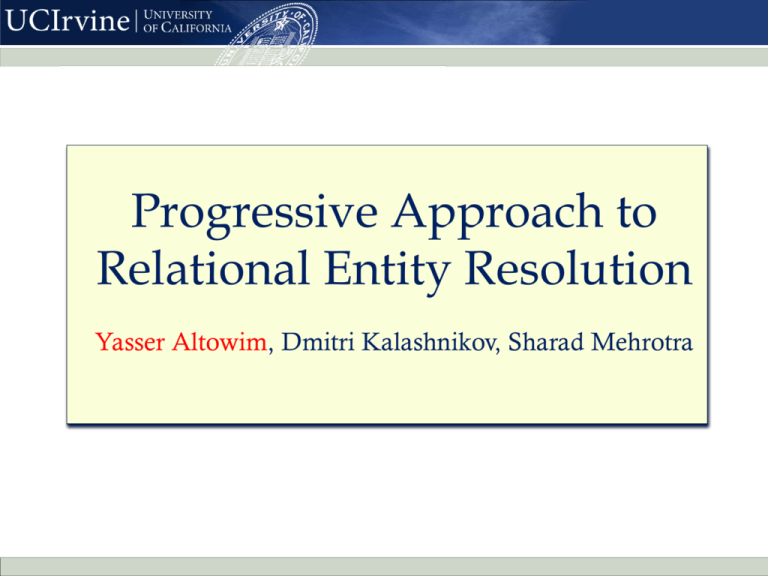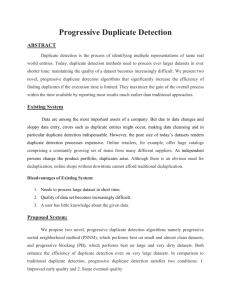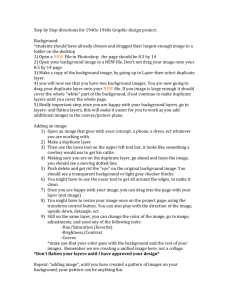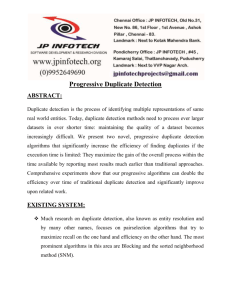Full Slide
advertisement

Progressive Approach to
Relational Entity Resolution
Yasser Altowim, Dmitri Kalashnikov, Sharad Mehrotra
Data Processing Flow
Quality
Data of
Data
Data Cleaning
Accounts For:
80%
Quality of
Analysis
Analysis
Quality of
Decision
Decision
Data Quality Challenges
Erroneous Values.
Missing Values.
Duplication.
…
Entity Resolution (ER)
Michael Jordan
Basketball Player
Real
World
Objects
Digital
World
Entities
Michael Jordan
Professor @ UCB
Entity Resolution (ER)
Id
Product Name
Price
p1
IPad Two 16GB WiFi
$490
p2
IPad 2nd Generatation 16GB WiFi
$469
p3
Apple Phone 4 32 GB
$545
p4
Apple iPod Shuffle 2GB
$49
p5
IPhone 4th Generation 32GB
$520
P1
P2
P4
P3
P5
Blocking
Dataset
BF1
Id
Product Name
Price
p1
IPad Two 16GB WiFi
$490
p2
IPad 2nd Generatation 16GB WiFi
$469
p3
Apple Phone 4 32 GB
$545
p4
Apple iPod Shuffle 2GB
$49
p5
IPhone 4th Generation 32GB
$520
…
Blocks
BF2
BF = 1st char of product name
p1
…
Blocks
p5
p2
p3
Blocks
p4
Similarity Computation
Id
Product Name
Price
p3
Apple Phone 4 32 GB
$545
p4
Apple iPod Shuffle 2GB
$49
Similarity Functions:
𝑓1 , 𝑓2 , … , 𝑓𝑛
𝑓1 (“Apple Phone 4 32 GB”, “Apple iPod Shuffle 2GB” ) = 0.125
Resolve Function:
Resolve(𝑜𝑢𝑡 𝑓1 , 𝑜𝑢𝑡 𝑓2 , … , 𝑜𝑢𝑡 𝑓𝑛 )
= duplicate, distinct, or uncertain
Progressive ER
Cost vs. Quality
Quality
Progressive ER
Resolution Cost
Real-time Analysis of Big Data
Applications
Event Monitoring
Situational Awareness
Real-time Alerts
Semantic Search
Anti-terrorism
Data
Cleaning
How Progressive ER Helps
Continually
Refined Results
Progressive Analysis
Progressive Data Cleaning
Relational Dataset
Paper
Id
p1
Title
Transaction Support in Read Optimized …
Authors
{a1, a2}
Venue
u1
p2
Read Optimized File System Designs: …
{a1}
u2
p3
Transaction Support in Read Optimized …
{a3, a4}
u3
p4
Berkeley DB: A Retrospective ..
{a3}
u4
Author
Venue
Marge Seltzer
Papers
{p1, p2}
Id
u1
Very Large Data Bases
Papers
{p1}
a2
Michael Stonebraker
{p1}
u2
ICDE Conference
{p2}
a3
Margo I. Seltzer
{p3, p4}
u3
VLDB
{p3}
a4
M. Stonebraker
{p3}
u4
IEEE Data Eng. Bull
{p4}
Id
a1
Name
Name
Graph Representation
p 1 , p3
u1, u3
duplicate
Resolve
duplicate
Problem Definition
Given a relational dataset D, and a cost budget BG,
Our goal is to develop a progressive approach that
produces a high-quality result using BG units of cost.
ER Graph
R1
S1
T1
R2
S2
T2
ER Graph
v1
v2
v3
v5
v6
v7
v9
v10
v11
R1
S1
T1
v4
v8
v12
R2
S2
T2
Partially Constructed Graph
v1
v2
v3
v5
v6
v7
v9
v10
v11
R1
S1
T1
v4
v8
v12
R2
S2
T2
Overview
BG
Window 1
Window 2
…
1. Plan Generation.
2. Plan Execution (
Resolution Plan ( )
Set of blocks (
Set of nodes (
Window n
).
) to be instantiated.
) to be resolved.
Plan Execution Phase
v1
v2
v3
v5
v6
v7
v9
v10
v11
R1
S1
T1
v4
v8
v12
R2
S2
T2
Plan Cost and Benefit
Node Benefit
…
…
…
State
v
v
v
1
v
2
Direct
Benefit
3
4
v
v
…
5
…
6
…
Indirect
Benefit
Probability Estimation
Noisy-OR Model
Cause
Cause …
Effect
Cause
Effect:
Node vi being duplicate.
Causes:
Influencing duplicate nodes
of vi.
Block to which vi belongs.
Fraction of duplicate
pairs in the block.
Example
duplicate
duplicate
v1
v2
v3
v5
v6
v7
R1
S1
T1
v4
v8
v12
R2
S2
T2
v1
duplicate
distinct
v2
v9
v10
v11
S1
Node Impact
v1
v4
v5
v6
v7
v2
v3
…
…
Dependent Nodes
…
…
Nearest Nodes (K=2)
Why?
1. Belief Update NP-hard.
2. The Nearest Nodes are not
always instantiated.
Impact Model
v1
v2
v3
Case#1
v4
v5
v6
v7
v1
v2
v3
Case#2
v4
v5
v6
v7
v1
v2
v3
Case#3
v4
v5
v6
v7
Plan Generation Phase
1.
Benefit-vs-Cost Analysis:
2.
Each node and block has an updated cost
and benefit.
Generate a plan such that:
h.
is maximized.
NP-hard
Oregon-Trail
Knapsack
Plan Generation Algorithm
Step#1
Instantiated
Unresolved Nodes
v1
v2
v4
v1
v6 v7 v10 v13
v15 v16 v21
Uninstantiated Blocks
Step#2
R1
R6
R2
R8
R4
R9
R5
v2
v10 v16
v6
Plan Generation Algorithm
R1 … R8
Step#3
R6
R2
v1
v4030 v4232 v4534
v4736 v4838
v1
v2
v10 v16
v6
v2
v10 v30
If
>
else
return
and
Lazy Resolution with Workflow
v
1
How to
resolve v1?
Resolve
Resolve
duplicate
or distinct
duplicate
or distinct
…
Workflow of v1
Contribution of Functions
For each function 𝑓𝑖
Positive Contribution
:
𝑡𝑖+ ∈ [0,1]:
The amount of positive evidence that the function
is expected to provide when applied on a duplicate
pair of entities.
Negative Contribution
𝑡𝑖− ∈ [0,1]:
The amount of negative evidence that the function
is expected to provide when applied on a distinct
pair of entities.
Workflow Generation
vi
1. Compute a utility value for each function 𝑓𝑗 :
2. Sort functions in a decreasing order based on
their utility values.
Workflow Generation
Pre-generate 𝑚 workflows:
Workflows:
𝑊𝐹1 … 𝑊𝐹𝑗 … 𝑊𝐹𝑚
Values of 𝜃 :
𝑗−1
𝑚
0
vi
…
…
𝑚−1
𝑚
Resolution Cost
Given a node vi and workflow 𝑊𝐹𝑗
Resolution Cost when
i is duplicate.
v
Resolution Cost when
i is distinct.
v
Experimental Evaluation
CiteSeerX Dataset
1. Papers (P) = (Title, Abstract, Keywords, Authors, Venue).
2. Authors (A) = (Name, Email, Affiliation, Address, Paper).
3. Venues (U) = (Name, Year, Pages, Papers).
Number
of Entities
Blocking
Functions
Similarity
Functions
Resolve
Function
P
30,000
2
3
Naïve Bayes
A
83,152
1
4
Naïve Bayes
U
30,000
1
3
Naïve Bayes
CiteSeerX - Blocking
Papers (P)
First three characters of title.
Last three characters of title.
Authors (A)
First one character of first name appended with the
first two characters of last name.
Venues (U)
First two characters of name appended with the first
two digits of year.
Experimental Evaluation
Algorithms:
1. DepGraph.
X. Dong et al. Reference reconciliation in complex
information spaces. SIGMOD.
2. Static.
S. E. Whang et al. Joint entity resolution. ICDE.
R
T
S
S2 … S6 S5 T6 … T1 T3 R1 … R4 R5
3. Full:
No lazy resolution strategy.
4. Random:
Lazy resolution strategy but with random order.
Time vs. Recall
Lazy Resolution with Workflow
Our Approach
Random
Full
Execution Time (sec)
300.33
396.55
542.43
Plan Generation
4.76%
3.81%
2.58%
Reading
Plan Execution
Blocks
95.11%
4.70%
96.17%
3.75%
2.90%
97.40
Graph
Creation
Reading
Blocks.
8.40%
6.25%
4.72%
Resolution
Creating Nodes.
Node
82.01%
86.17%
89.78%
Resolving Nodes.
Lazy Resolution with Workflow #2
Number of Sim Functions
P
A
U
Set_1
3
4
3
Set_2
2
2
2
Set_3
1
1
1
Correlation Among Sim Functions
Synthetic Dataset
Parameter
Description
Value
n
Number of entity-sets
4
s
Number of entities per entity-set
20,000
b
Number of blocks per entity-set
100
d
Fraction of duplicate pairs in each entity-set
0.2
z
Zipfian distribution exponent
0.15
l
Probability of generating an influence
0.3
Duplicate Distribution
Z = 0.00
0.15
0.30
Number Of Influences
0.0
0.3
l = 0.6
Conclusion
Progressive Approach to Relational ER.
Cost and benefit model for generating a resolution
plan.
Lazy resolution strategy to resolve nodes with the
least amount of cost.
Experiments on publication and synthetic datasets
to demonstrate the efficiency of our approach.
Questions






